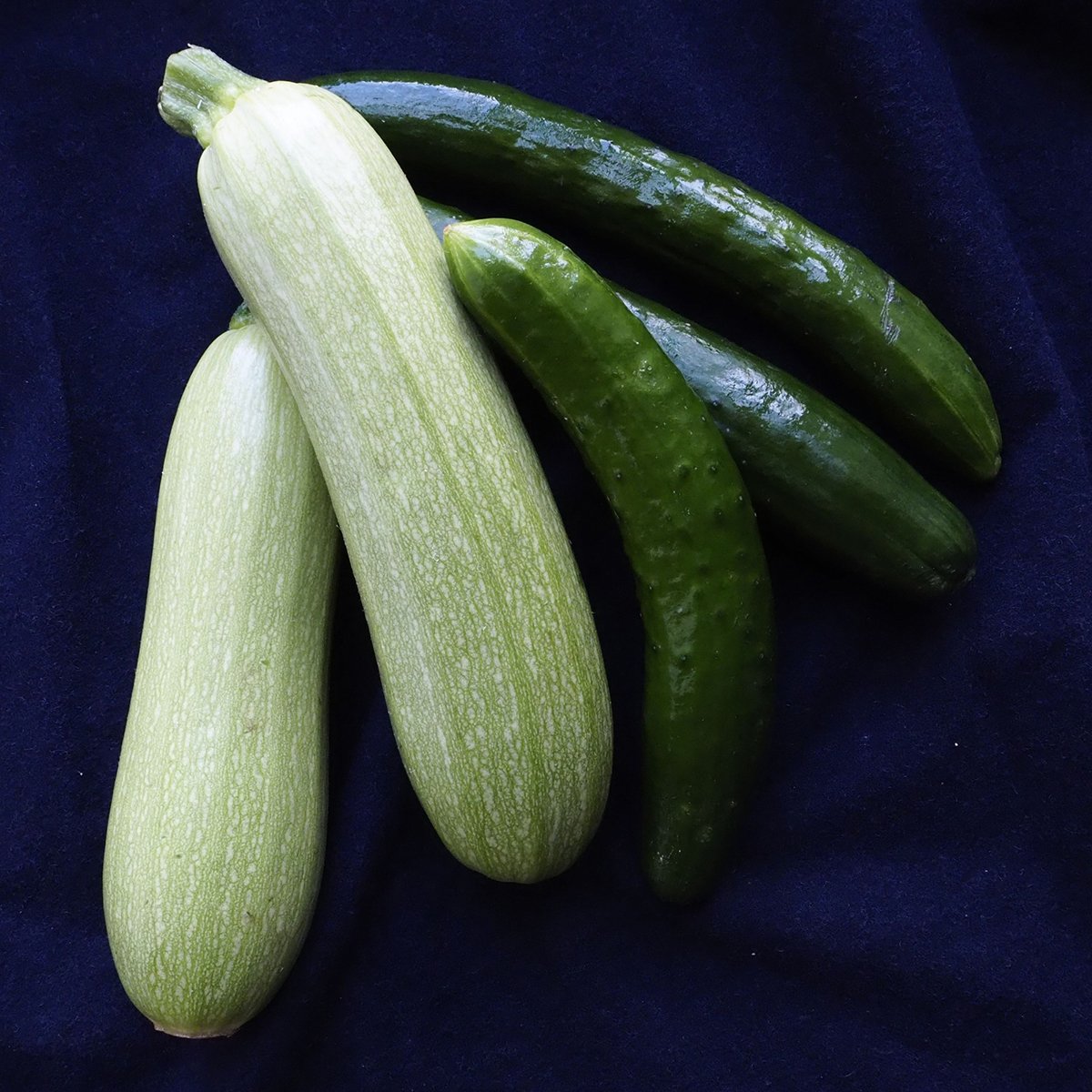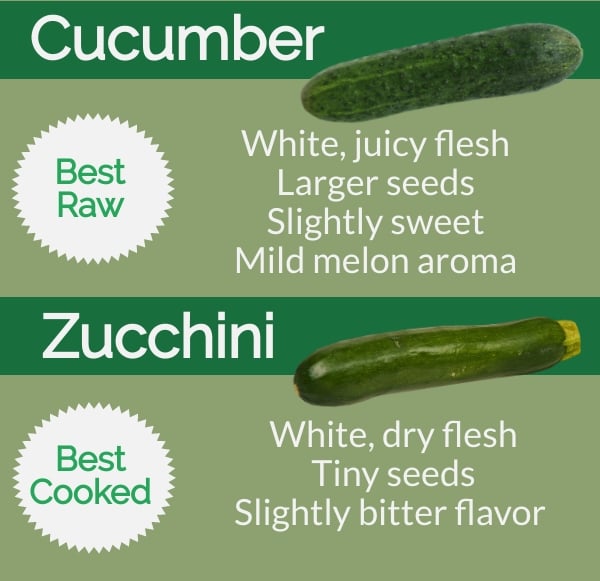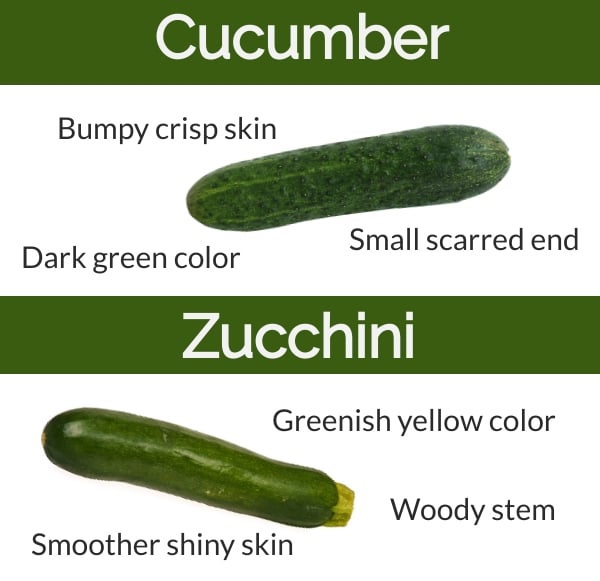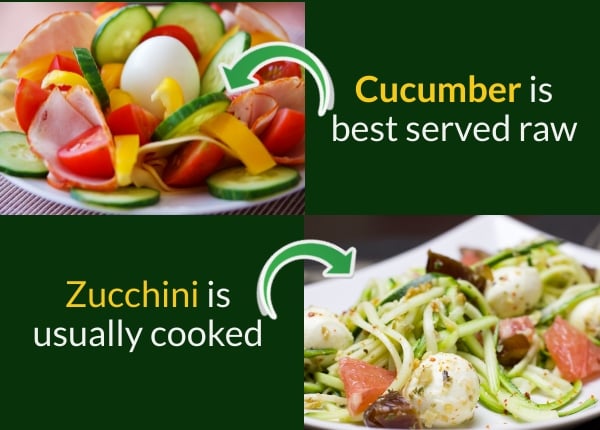The main difference between zucchini and cucumber is their texture; zucchinis have a smoother texture and are warmer to the touch, while cucumbers have a bumpier texture and are cold to the touch. You can also differentiate them by looking at their end; zucchinis have a woody stem, while cucumbers have a small, scarred end.

Once you open them, you will also discover that zucchini have drier flesh and tiny seeds compared to the juicy flesh and larger seeds you get with cucumbers. Moreover, these two fruits also differ in taste, origin, nutritional value, and uses in the kitchen. Read on to learn everything regarding this topic.
Fun Fact: The cucumber and zucchini are both actually fruits as they have seeds and result from a flower. However, in the kitchen, they are used as a vegetable.
Prefer to watch rather than read? Check out this video...
Table of Contents
Comparing Zucchini and Cucumber
Raw taste
Cucumbers are a crisp, juicy vegetable that can be eaten raw, skin and all. They taste slightly sweet with a faint melon aroma. The initial flavors are followed up with a soft bitter taste that isn’t overpowering.

Zucchinis, also known as courgettes, are virtually flavorless although there is a mild hint of earthy, bitter flavor. They contain less juice and tend to have relatively small seeds in the center, when compared to the cucumber.
Cooked taste
Cukes are usually eaten raw; however, if you decide to cook them you’ll find they soften and lose what little taste they had when raw. If you're interested in learning more about cucumber preparation then check out our beginners cutting technique video here.
Zucchini also softens when cooked and will take on a slightly sweet taste as well as absorbing the flavors of other dominant ingredients it is cooked with. Even when simply cooked with butter, the zucchini will soak up this flavor making a potentially delicious side dish. Zucchini will never overpower a dish, instead taking on the role of reliable sidekick.
Texture
The raw cucumber has soft, juicy flesh encased in a crispy skin; the seeds are usually larger than the zucchinis although they are fine to eat.
Zucchinis have a tougher flesh that can be eaten raw, but is much improved by cooking until tender.
Size and shape
Zucchinis can range in size from the length and width of a small cucumber through to a melon! In fact, a zucchini left on the vine to ripen will transform into a marrow. At this stage, it is easy to tell them apart. However, in supermarkets the zucchini is a size that is comparable to a cucumber which makes it more difficult.

The biggest external difference is the skin. You’ll notice that zucchinis have a waxy, shiny surface whereas the cucumber has a duller complexion with tiny bumps (nibs) all over it. Another key difference is the stem which is woody on the zucchini whilst the cucumber has a rough bump with very little stalk.
The flesh of a zucchini is dry and whitish yellow in color with very small seeds; although the interior of a zucchini is firm, it is still soft and easy to cut through. A cucumber has a thicker skin and a white colored crisp, juicy inside. Towards the center the flesh becomes soft and there are larger seeds. As a cucumber matures on the vine the seeds grow larger.
Related articles:
Find out how to freeze zucchinis.
What are some useful winter melon substitutes?
What does cucamelon taste like?
What are the best chayote substitutes?
Nutritional Content
Cucumbers
Water content: 95%
1 cup contains:
- Calories: 16
- Carbohydrates: 4g
- Fat: 0g
Zucchini
Water content: 95%
1 cup contains:
- Calories: 19
- Carbohydrates: 3.5g
- Fat: 0g
Origin
The zucchini is a variety of squash which originated from the Americas. It wasn’t until the late 1800’s that the Italians developed the zucchini into a format that we recognize in the shops today.
The cucumber is a member of the gourd family and is believed to have been cultivated in India over 3000 years ago. It is believed that North America began producing cucumber in the 1500s.
Best Uses in the Kitchen
In most cases, cucumbers are prepared raw and zucchinis are cooked. The texture of raw zucchini isn’t pleasant unless sliced very thinly. Cucumbers offer a refreshing, crispy addition to dishes if they’re left raw. Few recipes call for them to be cooked as they soften and lose their biggest strength – crispness.
With both of these vegetables it is usually best to keep the skin on. This where much of the nutritional content is found; the skin also adds color and texture to the dish.
The flowers of both the cucumber and zucchini are edible. Use them to make fritters; stuff them with a mixture of ground beef, onions and chili; in salads or simply as a garnish.

Cucumbers
- Eaten raw out of hand
- Sandwiches
- Bahn Mi
- Salads
- Beverages
- Pickled
- Raita
Zucchinis
- Sautéed in butter, boiled or roasted
- Stir fries
- Vegetarian noodles
- Muffins
- Stuffed zucchini
- Bread
- Lasagna
- Frittata
- Vege chips
Wrapping it up
When comparing cucumber vs zucchini it looks like they’re fairly similar, perhaps even from the same family? In fact they’re not.
There are some similarities: if harvested at the right time they can look a similar size; they’re also a similar shape and color. At a stretch you could argue that they both have very mild, almost bland flavor profiles.
Even with these similarities, they are actually very different and each has its own use in the kitchen. You certainly couldn’t substitute one for the other, like you might consider doing with hoisin and oyster sauce or camembert and brie. The best way to sum up these two ingredients would be: cucumbers are best eaten raw and offer a crispy texture and freshness to food. Zucchinis are best cooked and they excel at taking on the flavors of other stronger-flavored ingredients in the dish.

Leave a Reply